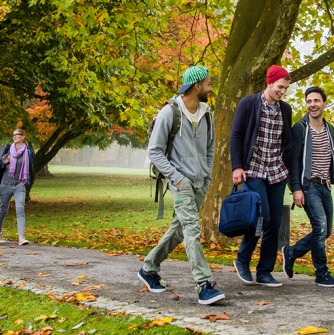Occupational therapy faculty member Twyla Fink received a summer mini-grant from the Center for Teaching Innovation. Professor Fink identified the teaching-and-learning technique “Walk and Talk” as her mini-grant topic. Here is what she has to tell us about what she learned:
What is Walk and Talk?
Walk and Talk is exactly what it sounds like – students walk together in pairs or small groups and talk about a topic related to what we are learning in class. This teaching and learning activity is flexible in design and content, making it suitable for a wide range of learners and classes. It can be used to meet a broad range of learning outcomes (Nolfi & Gischlar, 2020).
In fall 2023, I used this strategy within a first-year graduate course to:
- Give students a low-stakes, informal opportunity to discuss class concepts;
- Make social connections with peers;
- Provide a movement break outdoors.
Benefits of Walk and Talk
Walk and Talk gained popularity in business and health settings during the height of the COVID-19 pandemic, when groups of people felt safer spending time together outdoors (Borlioni, 2023; Jonas, 2021). Versions of Walk and Talk activities are also used in K-12 education settings (UC Berkeley, 2015). Studies (Borolini, 2023; Klee & Hirko, 2020; Kolomitro et al., 2020; Nolfi & Gischlar, 2020; Oppezzo & Schwartz, 2014) show that there are diverse benefits to having walking meetings or walking rounds, including:
- Increased creative thinking;
- Improved attention and concentration;
- Decreased mental fatigue;
- Improved sense of wellness;
- Provides dedicated, distraction-free work time;
- Builds community with colleagues.
Case Study: First-Semester Graduate Class
In fall 2023, while teaching a first-semester, first-year graduate course in occupational therapy, I integrated the Walk and Talk activity into weekly evening classes. Many graduate students attend class after working all day and then commuting to class, so my aim was to build a learning experience that could offer physical movement and mental stimulation while also creatively meeting course learning objectives. I was mindful that this activity would also allow students a bit of time to make social connections and foster a supportive learning community.
During the Walks and Talks, students mainly discussed key concepts covered in assigned readings, which students completed before class. Students walked in assigned pairs and discussed five to eight questions or discussion prompts printed on cue cards for each pair. Learning objectives ranged from asking students to identify/recall concepts to having them apply or evaluate. For example, after reading a theoretical paper, students may be asked to compare and contrast two key ideas. Or, after reviewing a case study in class, students may be tasked with suggesting potential solutions or treatment approaches. Each class, as weather and daylight allowed, we walked along the quiet streets around South Campus for about 15 to 20 minutes, and then returned to class to debrief all together. All in all, the activity took about 30 to 45 minutes to complete.
Observations
During the Walk and Talks, I observed that the students remained on task, and worked through each prompt at their own pace. Students appeared relaxed and comfortable, and I noted consistent participation across students, even from those who frequently refrain from participating in the traditional classroom setting. Informal feedback from students suggested that the Walk and Talk activity was:
- a fun, active break from seated lecture time in class;
- an informal way to mull over ideas with peers;
- sparked ideas and brainstorming opportunities;
- a chance for them to learn about and from each other.
I’d recommend the Walk and Talk activity. It gets students outside, can be used as a movement break during didactic teaching, and it builds community! I’ll be using this teaching strategy again once the weather improves.

